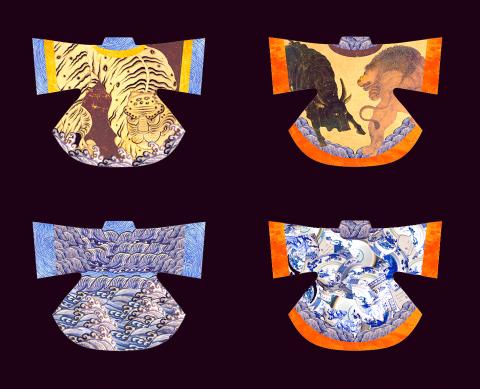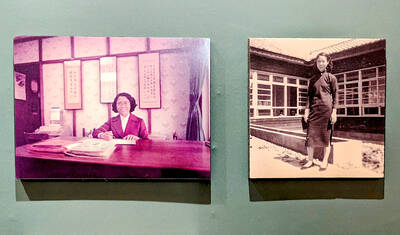Taiyuan Puppet Theatre Company’s (台原偶戲團) Pilgrimage, which opens on Wednesday, is a very different puppetry experience, even by the group’s own unconventional standards.
Most of the action takes place in a wading pool on the floor of the Nadou Theater (納豆劇場) to the accompanied of a live accordion, guitar and erhu (二胡) combo, and the puppeteers wear black neoprene bodysuits.
Taking inspiration from two great ocean travelers, Pilgrimage does not so much tell a story as create an abstract work of images and sounds that explores the worlds of the Ming Dynasty general Koxinga (國姓爺) (also known as Zheng Chenggong (鄭成功)), who built a short-lived fiefdom based on Taiwan in the 17th century, and the Portuguese soldier-poet Luis Vaz de Camoes, who explored Asia in the 16th century and whose Chinese lover died in a shipwreck. And added to that highly eclectic mix of characters are a Brazilian leprechaun called Saci, the African deity Yemanja and the ocean goddess Matsu (媽祖).

Photo courtesy of the Taiyuan Puppet Theatre Company
Boundaries of time and place are transcended in Pilgrimage’s tale of love, birth, death, the transitory nature of existence and, above all, the ocean’s ability to bring people together and to tear them apart again.
Staging the production presented Taiyuan Puppet Theatre Company with many technical problems, not least because the puppeteers must spend much of the performance partly submerged.
During a rehearsal earlier this week, the puppeteers huddled next to a fan heater to regain some body warmth after more than an hour splashing about, and occasionally floundering, in the pool.

Photo courtesy of the Taiyuan Puppet Theatre Company
“The theater represents reality, and as these stories take place on the ocean, the most direct way to represent them is with water,” director Wu Shan-shan (伍姍姍) said during a rehearsal break. “I have taken the simplest and the most difficult route. It is also the most direct route.”
But the water is much more than a production gimmick. In addition to the not-so-metaphorical reference to the ocean, through which all the characters and locations are linked, the water also alters the small theater’s visual and audio dynamics.
Taiyuan’s Pilgrimage uses images and music rather than dialogue or narration to tell its story.
“The stories of puppet theater where generally told through words,” Wu said, adding that Taiyuan, in its experimental productions at least, aimed “to show rather than to tell.”
This approach has given birth to innovative theatrical devices that increase the puppets’ expressiveness.
In Pilgrimage, not only do the puppets interact with human actors, the puppeteers themselves take part in the action. Their hands often serve as the puppet’s hands, providing the puppets with a whole new expressive dimension.
It is techniques like this, and the need for audience members to put aside representational expectations, that make new Taiyuan shows so exciting.
It is also worth pointing out that while Pilgrimage is staged by a puppet theater company and makes extensive use of puppets, the cast includes two highly accomplished contemporary dancers who play an integral part in generating the production’s on-stage dynamism.
While there is some dialogue in the show, the words form part of a soundscape created by Huang Si-nung (黃思農), the founder of the experimental theater group Against Again Troupe (再拒劇團), who has created a musical fabric woven from European folk melodies, Chinese operatic tunes, electronic sound manipulation and poetry read in Chinese
and Portuguese.
Pilgrimage shares many similarities with earlier Taiyuan productions, but its format, with widely diverse, even incongruous elements, linked together by their common association with the sea, is much more flexible.
Once the technical challenges are overcome, said Wu, the structural framework developed for Pilgrimage will be used to bring more stories to the stage.

Following the shock complete failure of all the recall votes against Chinese Nationalist Party (KMT) lawmakers on July 26, pan-blue supporters and the Chinese Communist Party (CCP) were giddy with victory. A notable exception was KMT Chairman Eric Chu (朱立倫), who knew better. At a press conference on July 29, he bowed deeply in gratitude to the voters and said the recalls were “not about which party won or lost, but were a great victory for the Taiwanese voters.” The entire recall process was a disaster for both the KMT and the Democratic Progressive Party (DPP). The only bright spot for

Aug. 11 to Aug. 17 Those who never heard of architect Hsiu Tse-lan (修澤蘭) must have seen her work — on the reverse of the NT$100 bill is the Yangmingshan Zhongshan Hall (陽明山中山樓). Then-president Chiang Kai-shek (蔣介石) reportedly hand-picked her for the job and gave her just 13 months to complete it in time for the centennial of Republic of China founder Sun Yat-sen’s birth on Nov. 12, 1966. Another landmark project is Garden City (花園新城) in New Taipei City’s Sindian District (新店) — Taiwan’s first mountainside planned community, which Hsiu initiated in 1968. She was involved in every stage, from selecting

Water management is one of the most powerful forces shaping modern Taiwan’s landscapes and politics. Many of Taiwan’s township and county boundaries are defined by watersheds. The current course of the mighty Jhuoshuei River (濁水溪) was largely established by Japanese embankment building during the 1918-1923 period. Taoyuan is dotted with ponds constructed by settlers from China during the Qing period. Countless local civic actions have been driven by opposition to water projects. Last week something like 2,600mm of rain fell on southern Taiwan in seven days, peaking at over 2,800mm in Duona (多納) in Kaohsiung’s Maolin District (茂林), according to

As last month dawned, the Democratic Progressive Party (DPP) was in a good position. The recall campaigns had strong momentum, polling showed many Chinese Nationalist Party (KMT) lawmakers at risk of recall and even the KMT was bracing for losing seats while facing a tsunami of voter fraud investigations. Polling pointed to some of the recalls being a lock for victory. Though in most districts the majority was against recalling their lawmaker, among voters “definitely” planning to vote, there were double-digit margins in favor of recall in at least five districts, with three districts near or above 20 percent in